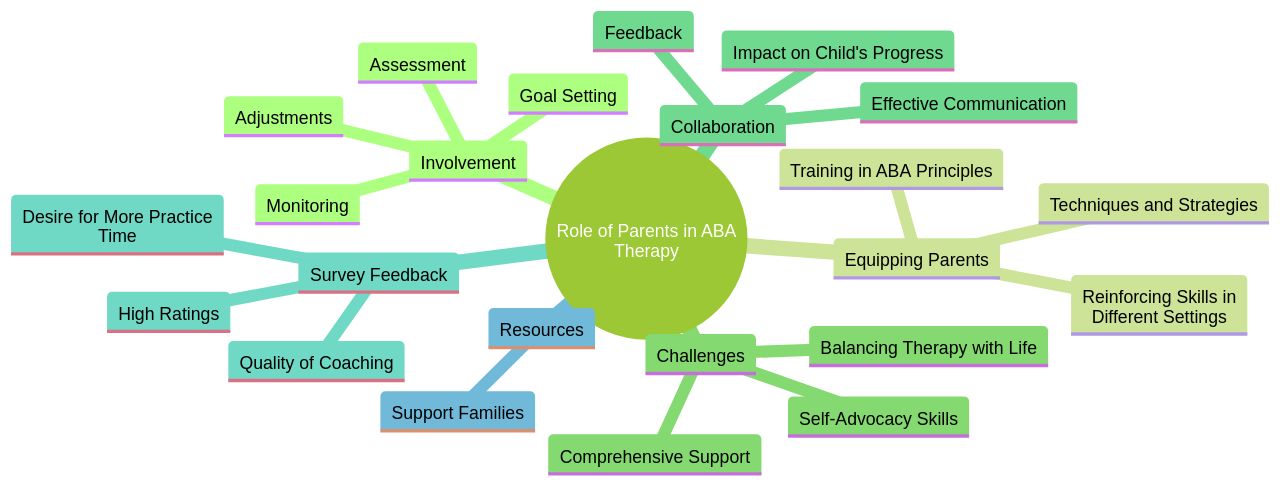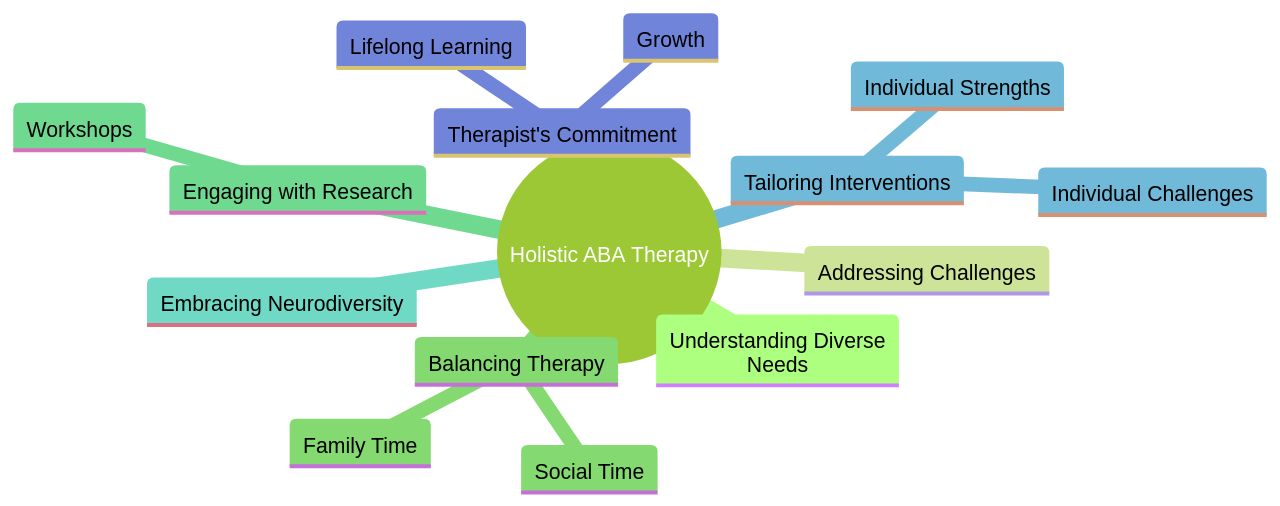Introduction
To enhance the effectiveness of ABA therapy, cultivating a collaborative environment is crucial. This fosters open dialogue and teamwork among behavior analysts, therapists, and support staff, leading to tailored intervention strategies that meet the unique needs of each child. However, it's important to find a balance between the intensity of therapy and the overall well-being of the child and their family.
The misconception that more therapy hours always equate to better outcomes is challenged, and a flexible approach that considers the family's financial situation and therapy-life balance is essential. In this article, we will explore the importance of collaboration, consistency in data collection, individualized treatment plans, parent collaboration and involvement, and continuous professional development in the realm of ABA therapy. Join us as we provide guidance and resources to empower Parent Advocates in navigating these key aspects of ABA therapy.
Creating a Collaborative Environment
To enhance the effectiveness and impact of ABA therapy, it's crucial to cultivate an environment of collaboration within the treatment setting. This means encouraging a culture where behavior analysts, therapists, and support staff can engage in open dialogue and work as a cohesive unit.
Such an inclusive approach allows for the exchange of innovative ideas and insights, leading to tailored intervention strategies that are more likely to meet the unique needs of each child. For instance, in cases where children may present complex behaviors, like Logan who expressed himself by throwing toys, the response of a therapist who mirrors the action can create a pivotal moment of connection and understanding.
This collaborative spirit was evident in the session where design-thinking experts and English-speaking professionals merged their expertise, resulting in a brainstorming session that integrated sensory integration training with ABA practices. However, it's important to remember that the intensity of ABA therapy should be balanced with the child's and family's overall well-being.
The misconception that 'more is better' is challenged by the diverse needs and outcomes of individuals with autism. Excessive hours of therapy can intrude on family privacy, limit social involvement, and strain familial relationships. In fact, findings suggest that some individuals may achieve better outcomes with fewer hours of therapy, which contradicts the assumption that more hours always equate to more progress. Therefore, it's essential to adopt a flexible ABA therapy model that considers the family's financial situation, care coordination, and the importance of therapy-life balance, ensuring that treatment gains made in the clinic are transferable to other environments. Ultimately, the goal is to create a supportive and adaptable ABA therapy framework that respects the neurodiversity of the community and aligns with the best interests of the child and their family.
Consistency and Data Collection
In the realm of ABA therapy, the notion that more hours equate to better outcomes is being closely scrutinized. A tailored approach, one that carefully weighs a family's unique needs and circumstances, is paramount. The intensity of therapy, often suggested at 30+ hours a week, brings with it a host of considerations.
It's not merely the financial burden that weighs heavily on families, but also the encroachment on their privacy, the disruption of work-life balance, and the strain on relationships within the household. The presence of therapists for extended periods can limit social engagements and community involvement, crucial for the holistic development of the child and family unity. Moreover, children who undergo ABA therapy in clinic settings face the additional challenges of travel time and a potential lack of treatment generalization across environments.
The emerging evidence suggests that a more focused treatment regimen, possibly entailing fewer hours, may lead to more favorable outcomes for some, challenging the traditional assumption that 'more is better.' Therefore, it's essential to adopt a flexible, individualized framework that prioritizes the well-being of the child and their family, fostering a harmonious therapy-life balance. This approach not only respects the family's daily life but also acknowledges that each child's path to progress is unique.
Individualized Treatment Plans
In the realm of ABA therapy, a tailored approach is paramount, recognizing that each child's journey is unique. The therapy must adapt to the child's specific skills and deficits, as well as their personal interests and aspirations. This individualized strategy should be informed by a thorough evaluation and followed by a customized treatment plan that zeroes in on areas needing intervention.
It's about striking the right balance; a recent study suggests that the duration of therapy may be more crucial than the number of hours per week, highlighting the importance of quality over quantity. The well-being of the child and their family is central, and hence, therapy schedules must be mindful of the family's financial situation, privacy, and the child's social engagements. According to Zoe Gross from the Autistic Self Advocacy Network, while there's debate about ABA's principles, what's clear is the need for shared decision-making and collaboration with families.
The aim is to optimize ABA therapy for each child, moving away from rigid models that don't account for the dynamic needs of the child and the family. Dr. Jeffrey Raskin's pioneering work in cerebral palsy with computer-guided radiofrequency ablation exemplifies the tailored, innovative approaches that can significantly enhance quality of life. Such individualization in treatment is crucial in ABA therapy, ensuring that interventions are not only effective but also respectful of the child's and family's lifestyle.
Parent Collaboration and Involvement
In the dynamic field of ABA therapy, the role of parents is pivotal. It's recognized that each child with autism or ADHD is distinct, necessitating a customized approach that begins with a comprehensive assessment by a Board Certified Behavior Analyst (BCBA). After setting specific, measurable goals, the therapy's success hinges on consistent monitoring and adjustments.
This tailored approach extends to parents, who are integral to maintaining progress at home and beyond. To optimize the benefits of ABA therapy, parents must be equipped with knowledge and resources. This includes training in ABA principles and techniques, alongside strategies for reinforcing skills in various settings.
By fostering a collaborative environment, parents gain the tools to support their child's development effectively. However, intensive therapy schedules can present challenges, such as intruding on family privacy, limiting work opportunities, and affecting relationships within the family. The necessity of balancing therapy with life's other aspects cannot be overstressed.
Recent developments, like California's Senate Bill 805, underscore the importance of offering families better options and empowering them with self-advocacy skills. As the ABA therapy industry evolves, it is crucial to provide families with comprehensive support that respects their unique circumstances, aligns with their values, and promotes a harmonious therapy-life balance. Through regular communication and feedback, families can navigate the therapy journey with confidence, ensuring that their child's progress in ABA therapy is not just a clinical success but a personal triumph.

Continuous Professional Development
For ABA therapists and behavior analysts, the pursuit of professional excellence is a dynamic and ongoing process. It's not merely about accruing hours of practice, but about deepening one's understanding of the diverse needs of individuals with autism.
The field is complex, with a spectrum of challenges that range from self-injurious behaviors to the subtleties of social interaction. Therapists must be equipped with a breadth of strategies to address these challenges effectively and sensitively.
Learning is a continuous journey that goes beyond traditional therapy hours. It involves critical reflection on the impact of therapy on a child's life, including the balance of therapy with family and social time.
ABA professionals are encouraged to embrace a holistic approach that considers the child's well-being in all aspects of their development. Engaging with the latest research, partaking in workshops, and exploring a variety of therapeutic approaches are indispensable for therapists to refine their practice.
This dedication not only enhances their skills but also aligns with the evolving understanding of autism and the neurodiversity paradigm. Moreover, the importance of tailored interventions cannot be overstated. Each child's journey is unique, and therapy must adapt to their individual strengths and challenges. The use of comprehensive evaluations, criterion-referenced tools like the VB-MAPP, and data-driven decision-making ensures that interventions are personalized and effective. ABA therapy is not a one-size-fits-all solution; it's a nuanced and adaptive process that thrives on the therapist's commitment to lifelong learning and growth.

Conclusion
In conclusion, collaboration and balance are key in ABA therapy. Creating a collaborative environment among professionals leads to tailored intervention strategies that meet each child's unique needs.
However, it's crucial to balance therapy intensity with the overall well-being of the child and their family. The misconception that more therapy hours always result in better outcomes is challenged by individual differences within the autism community.
Excessive hours can intrude on family privacy and strain relationships. A flexible approach is necessary, considering the family's financial situation and therapy-life balance.
Consistency in data collection is vital for effective ABA therapy. Personalized treatment plans that address specific skills and deficits should be implemented, focusing on quality over quantity.
The well-being of the child and family should guide therapy schedules. Parent collaboration and involvement play a pivotal role in optimizing the benefits of ABA therapy.
Equipping parents with knowledge and resources empowers them to support their child's development effectively. Balancing intensive therapy schedules with other aspects of life is essential. Continuous professional development is crucial for ABA therapists. Reflection, research, workshops, and exploration of therapeutic approaches enhance their skills. Tailored interventions for each child's unique journey are paramount. To navigate these aspects of ABA therapy, Parent Advocates should prioritize collaboration, consistency in data collection, individualized treatment plans, parent involvement, and continuous professional development. By doing so, they empower themselves with the knowledge and resources needed to ensure their children's well-being and progress in ABA therapy.




